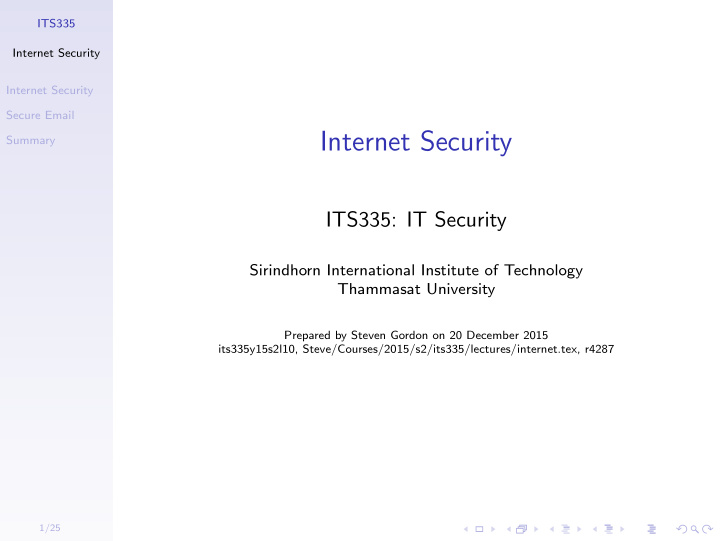



ITS335 Internet Security Internet Security Secure Email Internet Security Summary ITS335: IT Security Sirindhorn International Institute of Technology Thammasat University Prepared by Steven Gordon on 20 December 2015 its335y15s2l10, Steve/Courses/2015/s2/its335/lectures/internet.tex, r4287 1/25
ITS335 Contents Internet Security Internet Security Secure Email Summary Internet Security Secure Email Summary 2/25
ITS335 Internet Security Internet Security ◮ Many Internet protocols were designed assuming Internet Security trustworthy links, networks and devices Secure Email ◮ No security mechanisms built in to: IP, TCP, UDP, Summary HTTP, SMTP, . . . ◮ As networks/devices became less trustworthy, extensions were developed to add security to existing protocols and applications: IPsec, TLS, PGP, . . . ◮ Securing communications across the Internet can be performed at different layers: ◮ Application, transport, network, link 3/25
Internet Topology and Stack Example
Application Level Security: Application-Specific
ITS335 Application Level Security Internet Security Application (protocol) implements its own security Internet Security mechanisms Secure Email Examples Summary ◮ SSH, Email (OpenPGP, S/MIME), DNSSEC, . . . Advantages ◮ Host-to-host encryption ◮ Independent of operating system security features Disadvantages ◮ Each application must implement common security mechanisms 6/25
Transport Level Security: TLS/SSL
ITS335 Transport Level Security Internet Security Application uses OS provided library for security Internet Security Examples Secure Email Summary ◮ TLS/SSL for TCP-based applications, e.g. HTTPS, IMAPS, FTPS, SMTPS ◮ DTLS, SRTP for other transport protocols Advantages ◮ Host-to-host encryption ◮ Simpler applications; no need to implement complex security mechanisms Disadvantages ◮ Only applies for specific transport protocols ◮ Applications must be implemented to use OS API 8/25
Network Level Security: IPsec End-to-End
ITS335 Network Level Security Internet Security Computer configured to apply security mechanisms to IP Internet Security packets Secure Email Examples Summary ◮ IPsec Advantages ◮ Supports all applications and transport protocols ◮ Can be host-to-host encryption Disadvantages ◮ Requires support and configuration in OS Commonly used in tunnelling mode 10/25
Network Level Security: IPsec Host-to-Router
Network Level Security: IPsec Router-to-Router
ITS335 Network Level Security: Tunnelling Internet Security ◮ Tunnelling: packets at one layer are encapsulated into Internet Security packets at the same layer Secure Email ◮ Network layer: IP-in-IP, IP-in-IPsec Summary ◮ Application layer: SSH ◮ Data link layer: PPTP, L2TP ◮ Create a Virtual Private Network ◮ Support and configuration of security mechanisms can be provided on routers, rather than hosts ◮ Does not provide end-to-end encryption 13/25
Link Level Security: WPA
ITS335 Link Level Security Internet Security Examples Internet Security Secure Email ◮ WEP/WPA in wireless LANs, Bluetooth, ZigBee Summary encryption, GSM A3/A5/A8, . . . Advantages ◮ Applies to all data sent across link, independent of application, transport, network protocols Disadvantages ◮ Encryption only across the link ◮ Requires configuration of both link end-points 15/25
ITS335 Contents Internet Security Internet Security Secure Email Summary Internet Security Secure Email Summary 16/25
ITS335 Secure Email Internet Security ◮ Email messages originally only text with pre-defined Internet Security headers (To, From Subject, CC, . . . ) Secure Email ◮ Multipurpose Internet Mail Extensions (MIME) allows Summary for different message and header formats: different character sets, attachments, new headers ◮ Secure email requirements: 1. Authentication: receiver can confirm the actual sender, and that content is not modified 2. Confidentiality: only sender/receiver can read the contents ◮ Two common ways to implement secure email: 1. S/MIME 2. OpenPGP ◮ Both use similar approach: sender signs message with private key, encrypts message with symmetric key encryption using a secret key, and encrypts the secret key using recipients public key 17/25
ITS335 OpenPGP Internet Security ◮ Pretty Good Privacy (PGP) developed by Phil Internet Security Zimmerman in 1991 Secure Email ◮ IETF standardised as OpenPGP Summary ◮ One of first and most widely used applications of public-key cryptography ◮ Implementations: ◮ Original by Zimmerman: Symantec ◮ GNU Privacy Guard (GPG) ◮ Many email clients (either direct or through plugins, e.g. Enigmail, GPG4Win) ◮ OpenPGP vs S/MIME: ◮ OpenPGP: public keys distributed informally: phone, websites, email ◮ S/MIME: public keys distrubuted as X.509 digital certificates 18/25
ITS335 PGP Operation: Concept Internet Security Internet Security Secure Email Summary Credit:xaedes & jfreax & Acdx, Wikimedia Commons, CC Attribution-Share Alike 3.0 19/25
ITS335 PGP Operation: Message Generation at A Internet Security Internet Security Secure Email Summary Credit: Figure 18.5 in Stallings, Cryptography and Network Security , 5th Ed., Pearson 2011 20/25
ITS335 PGP Operation: Message Reception at B Internet Security Internet Security Secure Email Summary Credit: Figure 18.6 in Stallings, Cryptography and Network Security , 5th Ed., Pearson 2011 21/25
ITS335 Contents Internet Security Internet Security Secure Email Summary Internet Security Secure Email Summary 22/25
ITS335 Key Points Internet Security ◮ Many Internet protocols have extensions to support Internet Security secure communications Secure Email ◮ Can apply security mechanisms at different layers: Summary application, transport, network, link ◮ Trade-offs between: complexity of applications, host-to-host encryption, required support in devices ◮ VPNs allow for connecting to networks and offering services as if you were physically attached to that network ◮ HTTPS used for web security ◮ OpenPGP and S/MIME common for email security 23/25
ITS335 Security Issues Internet Security ◮ Key distribution: must be sure public key is correct Internet Security ◮ Man-in-the-middle attacks are possible if public keys are Secure Email not authentic Summary ◮ Different support of algorithms/protocols by devices, operating systems and applications ◮ Bugs in implementations create security vulnerabilities 24/25
ITS335 Areas To Explore Internet Security ◮ Application level security: DNSSEC, OpenPGP and Internet Security S/MIME Secure Email ◮ Virtual private networks with IPsec, L2TP, PPTP and Summary others ◮ Trust levels with public key distrubtion 25/25
Recommend
More recommend